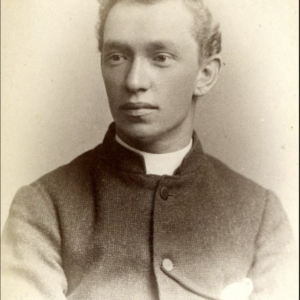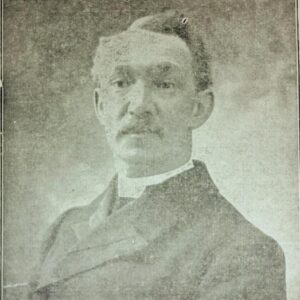 Rev. Henry Abraham (1860-1933) was Little Bay’s fourth Methodist minister; he was a pivotal figure whose influence extended beyond the pulpit. Serving from 1886 to 1889, his connection to the town began earlier, in 1883, when he was stationed at Betts Cove. In Little Bay, Abraham embodied many roles: he was a devoted father, a loving husband, a passionate minister, an inspiring teacher, and an activist. This article delves into the multifaceted life of Rev. Abraham, exploring how his roles and experiences shaped not only his own journey but also the community he served. From his adventurous beginnings in England to his impactful years in Newfoundland, and finally to his later life and tragic ending in the United States.
Rev. Henry Abraham (1860-1933) was Little Bay’s fourth Methodist minister; he was a pivotal figure whose influence extended beyond the pulpit. Serving from 1886 to 1889, his connection to the town began earlier, in 1883, when he was stationed at Betts Cove. In Little Bay, Abraham embodied many roles: he was a devoted father, a loving husband, a passionate minister, an inspiring teacher, and an activist. This article delves into the multifaceted life of Rev. Abraham, exploring how his roles and experiences shaped not only his own journey but also the community he served. From his adventurous beginnings in England to his impactful years in Newfoundland, and finally to his later life and tragic ending in the United States.
Before Little Bay
Henry Abraham’s journey began in the vibrant port town of Gosport, England, on January 17, 1860. Born into privilege as the son of Henry William and Fanny (Foster) Abraham, he was initially drawn to the arts, pursuing an apprenticeship in London as a sculptor. Yet, the adventurous tales of his siblings’ missionary work in Africa and India ignited a new passion within him, steering him toward theological training. He’d travel far, visiting; Palestine, Egypt, and much of Europe before setting his sights on the island of Newfoundland.
Several recently trained English Methodists were planning a mission to Newfoundland, but Rev. Henry Abraham arrived ahead of them in 1881. Initially stationed in Burgeo and later in LaPoile, he embraced his dual roles as a minister and educator, joining the Methodist school board in each location. By 1883, he was leading the parishes at Betts Cove and Tilt Cove, where he met John William Vickers, a fellow Englishman and Methodist leader in nearby Little Bay. Their shared commitment to community building and education forged a lifelong friendship. Abraham’s time in Newfoundland was marked by personal and professional growth, as he honed his ability to inspire and educate. In 1884, he left for New Brunswick to complete his education at Mount Allison University, further solidifying his dedication to both teaching and ministry.
Little Bay
In the summer of 1886 he returned ordained. Landing in St. John’s, he preached at the George Street Church and likely stayed with Rev. Milligan whose daughter would soon become Mrs. Abraham. Making his way back to the island’s northern mining region, he took over the post at Little Bay where he’d often visited his friend Rev. Vickers. Rev. Abraham arrived as a minister and a teacher to the place where he’d become a husband and a father. The town’s Temperance Movement would also make him an activist.
Little Bay’s Temperance Movement had been active for three years and the town was dangerously divided over the issue of alcohol. On December 13, 1886 Henry Abraham stood before Magistrate Blandford and delivered a speech stressing the dangers of alcohol in the mining town. He pointed out that he represented Little Bay’s Methodist community and produced a list of one hundred signatures supporting the cause.
Standing beside him were the town’s other two clergy; Rev. Clift of the Church of England and Father O’Flynn of the Catholic Church. They formed a united front for the town’s Temperance effort to plead for an end to liquor licensing. There was power in Rev. Abraham’s choice to represent his church alongside these peers. They won that day together. They embodied their churches and fully represented them standing together. Through their combined performances they used the power of the institutions they represented and it changed Little Bay.
In July of 1887 he took a trip back to St. John’s where on the 6th he wed Julia Burpee Milligan. Her father, Rev. G. S. Milligan, married them. The Milligans were known for their work with the city’s Methodist church. Julia would prove to be a worthy match for our protagonist. Among the wedding gifts was one from Little Bay’s Methodist Sunday school where Rev. Abraham taught. The new couple boarded a steamer for Little Bay that very day.
Rev. Abraham’s relationship with the town’s other clergy continued. Magistrate Blandford called on them to once again stand united. He needed their help organizing the Queen’s Jubilee celebrations to be held on August 11th, 1887. Each of the three selected two men and two women for committees to oversee the varied preparations. Rev. Abraham picked; Mr. Jones, Mr. Quenby, Mrs. Howson, and his wife Mrs. Abraham. They did an exceptional job. On the day celebrations were opened with a parade where the three clergymen marched together. Their unity was noteworthy as it contrasted with the situation elsewhere, most namely in Harbour Grace where denominational tensions had risen to violence. Little Bay’s ecclesiastical trio were setting a standard for religious tolerance. It was powerful.
Rev. Abraham was likely in town during the 1888 fire but I have no direct source for that yet. I do have sources for a few of his other notable encounters there.
On July 28, 1888 Little Bay was visited by Canadian Senator John McDonald. He was on the island more as a Methodist than as a politician. He was exploring the church’s operations from St. John’s to the coast of Labrador. Accompanying him was Julia’s father Rev. Milligan which likely contributed to the Little Bay visit. Interviewed back on the mainland later Senator McDonald praised the efforts of the Newfoundland Methodists. He’d been impressed by what he’d seen there.
Henry Abraham became a father on August 22, 1888. Julia gave birth to a daughter. They named her Helen. Maddie Paddock moved in with the Abraham’s to help out. She would become another of the family’s lifelong companions. On September 15, 1888 Rev. Abraham operated the magic lantern for an exhibition on the life of Joseph. Images from the story were cast forward in light. Schoolchildren watching were further entertained by the accompanying, dramatic storytelling. This event raised money for the new teacher, Mr. Garland. The last local event I’ve found highlighting Rev. Abraham’s role takes place in May of 1889 when he officiated at the anniversary of Little Bay Islands. He opened his speech by quoting the biblical passage “I pray that they all may be one” which served as theme and thesis to a sermon on unity.
After Little Bay
The Abrahams left Little Bay that summer, leaving behind a community that had come to appreciate their presence, including the town’s remaining Presbyterians. They presented them with a departure gift. Rev. Abraham had likely tended to them due to the absence of a Presbyterian minister. The Abrahams leaving marked the end of a significant chapter. They were missed.
 The family moved to Fogo, where their second daughter, Elizabeth, was born in 1891. In 1892, they set sail for the United States, settling first in Michigan until 1909, and then moving to Illinois. Here we find him preaching to Presbyterians properly and no longer in a Methodist church. Mrs. Abraham, a music lover, worked diligently to secure the organ for the Normal Presbyterian Church.
The family moved to Fogo, where their second daughter, Elizabeth, was born in 1891. In 1892, they set sail for the United States, settling first in Michigan until 1909, and then moving to Illinois. Here we find him preaching to Presbyterians properly and no longer in a Methodist church. Mrs. Abraham, a music lover, worked diligently to secure the organ for the Normal Presbyterian Church.
Julia Abraham fell ill and underwent an operation for cancer treatment in 1919, which left her bedridden. Rev. Abraham took charge of the Earlville church that year, securing an organ for it in 1922, fulfilling his wife’s wishes. She passed away on December 7, 1924, with Maddie Paddock, their lifelong companion, by her side. Rev. Vickers wrote a touching tribute to her for a Newfoundland newspaper, ensuring she was well remembered.
Two years later, while attending a national convention in San Francisco, Rev. Abraham decided to retire. He briefly visited England but returned to Illinois, where his daughters lived. His retirement lasted seven years. In 1933, facing illness, he went into his garage, used a mirror to aid his aim, and shot himself in the temple with a revolver. He left a note praising his daughters. Rev. Vickers attended his funeral, reminiscing about their first meeting in Little Bay.
Helen and Elizabeth Abraham, like their father, pursued careers in education, one as a teacher and the other as a librarian. They lived together in Bloomington until Helen’s death in 1941, with Rev. Vickers once again attending and once again making sure that Newfoundland knew. You can see his love for the family in his writing. Elizabeth, the last of the Abrahams, passed away in 1987.
Little Bay was known for it’s unusual culture, one highlighting a rather cosmopolitan and inclusive attitude toward mixed-denominational community building. The town’s church leaders were vital in that effort and it’s a cooperative spirit reflected well by Rev. Henry Abraham.
That’s it, folks. Thanks for reading about him and his family. And a special thanks to the Earlville Community Historical Society and Mount Allison University Archives for finding his pictures!
Notes
You can find my source list at the bottom.
I think there’s a good chance Rev. Abraham’s journals still exist. I have been reaching out to various institutions in Illinois inquiring but no luck so far. It’s a good guess they would have been with Elizabeth until 1987 so maybe someone reading can suggest where they went from there.
Oh, and I should point out that some genealogy sites have a third daughter for the family. There was no third daughter. I’m 100% certain on that. It comes from a census list but if you check the DOB it’s the same as Elizabeth. Plus lots of sources say only two.
I’m always looking for new material so if you got letters or journals from the town let me know. If you’d like to donate a dollar to help cover some of the subscription costs you can do so here but if you’d rather support the work with attention and praise you can follow the Facebook page here
Sources:
1860, Jan 17 – Henry Abraham was born in Gosport, England (Earlville Leader, Jan 26, 1933)
He had an interest in the arts and apprenticed as a sculptor in London (Earlville Leader, Jan 26, 1933)
His brother was a missionary in South Africa and his sister was a missionary in India (Earlville Leader, Jan 26, 1933)
He did theological training in London (Earlville Leader, Jan 26, 1933)
He was well travelled having been to Egypt, Israel, and many locations across Europe (Earlville Leader, Feb 23, 1933)
1881 – Arrived in Newfoundland from England (Earlville Leader, Feb 23, 1933)
1882, July 8 – Stationed at Burego (Harbour Grace Standard)
1882, Dec 20 – Left Burego for LaPoile. He served on the Methodist education board at both locations (Evening Telegram)
1883 – Rev. Vickers was stationed at Little Bay and began a friendship with Rev. Abraham which would last the rest of his life (Earlville Leader, Feb 23, 1933)
1883, June 30 – At the 10th Methodist Conference Rev. Abraham represented Betts Cove and Tilt Cove (ET)
1883, July 21 – Tilt Cove (HGS)
1883, Oct 3 – Left LaPoile for Betts Cove. He served on the Methodist education board at both locations (ET)
1883, Oct 6 – He was replacing Rev. J.J. Mawson (HGS)
1884, April – H. Abraham was stationed at Betts Cove when he took part in a missionary tour of the circuit (Twillingate Sun)
1884, July 26 – Left the district (HGS)
This is likely when he went to Sackville, New Brunswick to study at Mount Allison University (Earlville Leader, Feb 23, 1933)
1886, July 4- Spoke at George Street Church (ET)
1886, July – Rev. Abraham took the Plover to Little Bay (Daily Colonist)
1886, Dec – Signed petition concerning alcohol prohibition (“All Quiet” Wells, P. 160)
1887, Jan – Took a stand with the other clergy against alcohol (TS)
1887, March – Missionary meetings (TS)
1887, July – Rev. Henry Abraham stationed at Little Bay (TS)
1887, July 6 – Rev. Abraham married Julia Burpee Milligan (TS, July 16, 1887)
1887, July 16 – Returned to town with his new bride (TS)
1887, Aug – Rev. Abraham took part in the Queen’s Jubliee (TS/ET)
1887, Dec – Performed a Locke/Jeans wedding in Little Bay (TS/ET)
1888, Jan – Whyte and Morris weddings (TS)
1888, Feb – Performed Thompson and Phoran weddings (TS)
1888, March – Combs and Penny weddings (TS)
1888, March – Noble wedding (TS)
1888, April – Signed Temperance petition (HGS/TS)
1888, July – Stationed at Little Bay (ET)
1888, Sept – Gave a magic lantern exhibition (TS)
1888, Sept – Hosted visiting Canadian politician John McDonald (HGS)
1888, Sept – Had a daughter (TS)
1889, May – Officiated Little Bay Islands’ anniversary (TS)
1889, June – Departure letter to Little Bay (TS)
The Abrahams left for the United States with Maddie Paddock who had been living with them since the birth of their daughter (Daily News, Aug 4, 1923)
1889, July – Spoke at the Methodist Conference about about Temperance (Methodist Monthly Meeting)
1891 – Stationed at Fogo (Methodist Monthly Meeting)
1892, June – Speaks at Bonavista conference (Methodist Monthly Meeting)
1892 – Departs for Michigan (Methodist Monthly Meeting)
1893 – Letter from US (Methodist Monthly Meeting)
1909 – Started serving the Normal Presbyterian church (Earlville Leader, Jan 26, 1933)
He was Chaplain of the Illinois Soldiers and Sailors Children’s school (Earlville Leader, Jan 26, 1933)
Mrs. Abraham started the work to get the church an organ. Funding was secured by her and her husband (Earlville Leader, Feb 23, 1933)
1919 – Mrs. Julia Abraham had an operation for cancer treatment which injured her spine and left her invalid (Daily News, Aug 4, 1923)
1919, Dec – He started serving the Earlville Presbyterian church (Earlville Leader, Feb 23, 1933)
1922 – Oversaw the remodelling of Earlville church and the installation of its organ (Earlville Leader, Feb 23, 1933)
1923, Dec 7 – Death of his wife. She had been unable to move and in pain for four years. Miss Paddock was with her when she passed (Earlville Leader, Jan 26, 1933)
1925, Jan 17 – He celebrated his 65th birthday at the Earlville church (Earlville Leader, Jan 26, 1933)
1925, Aug – Rev. Abraham were vacationing in England (Earlville Leader, Aug 20, 1925)
1926 – Attended the national convention in San Fransisco and made the decision to retire upon his return (Earlville Leader, Feb 23, 1933)
1927, July – Retired from his position at Earlville church (Earlville Leader, Feb 23, 1933)
1928, Feb 18 – Dedication service for the updated Earlville church and its organ (Earlville Leader, Feb 23, 1933)
1933, Jan 24 – Shot himself in his garage in Bloomington. He was discovered when two women arrived to make him dinner. He had left a note. He died from his injuries that evening at the hospital (Earlville Leader, Jan 26, 1933)
1933, Jan 25 – His funeral was held at Second Presbyterian church, Bloomington, Illinois. His long time friend Rev. J.W. Vickers spoke (Earlville Leader, Feb 23, 1933)
1933, Oct 1 – Rev. Abraham’s daughter donated his picture to the Normal Presbyterian church for its 65th anniversary (Earlville Leader, Oct 5, 1933)
1941, Feb – Helen and Elizabeth were living together in Bloomington at the time of Helen’s death. Rev. Vickers was called to the funeral (Daily News, March 3, 1941)
